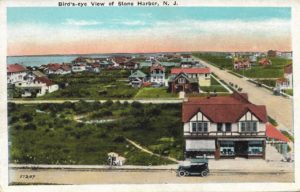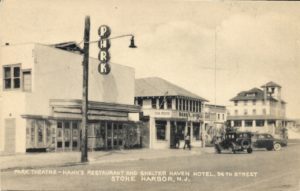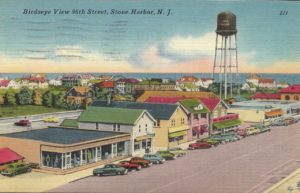In summer, Southerners flock to the beach, and California folks may visit the coast, but in Riverton, we go to the shore.
The social columns of the old hometown newspapers of Riverton and Palmyra (the Facebook posts of yesteryear) record many notices about local citizens’ summer plans.
Besides playing in the surf, our fondest summer memories may be about places we stayed, shopped, or ate.

EARLY BUSINESS GROWTH AT STONE HARBOR
by Harlan B. Radford, Jr.
As the population of Stone Harbor started to grow, a need developed for stores and other business enterprises to provide needed goods and services. The commercial development of Stone Harbor began around 1912 with continued housing construction and easier access to the island community, first by train and then by automobile.
A so-called commercial center or “downtown” began with the construction of the Shelter Haven Hotel, and before long, 96th Street became the primary shopping district. As one source* put it, “This vibrant shopping district exists because the Risleys recognized even though Stone Harbor was planned as a resort community, people who chose to make their permanent homes here would need more than just souvenir shops.” That same source declares, “As true a main street as one can find, Ninety-sixth Street is the heart of Stone Harbor.”
Let’s trace the early development of Stone Harbor’s business district with some vintage postcards.

The sign stretching across Third Avenue at the intersection of 96th Street reads “WELCOME TO STONE HARBOR.”
This is where our story begins.

The two-story shingled restaurant owned and operated by H. S. VanLeer depicted in this postcard dated July 16, 1910, was one of the earliest businesses established in Stone Harbor.
Catering mostly at first to the construction workers and laborers, this store provided patrons with a quick lunch. The posted menu for “Dave’s Quick Lunch” on that particular day offered oyster and clam stew, sandwiches and coffee, soft drinks, ice cream, pies, cakes, and candies along with fresh fish. A 46-star American Flag flutters in the breeze atop the flag pole. The folks on the porch may be a mix of customers, staff, or owners.

Rummel’s Store also served as a U.S. Post Office from 1894 to 1910. Located at 83rd Street and Second Avenue, this structure was very close to the Abbotsford Inn (later re-named Harbor Inn), shown in the background.
The young uniformed lads relaxing in the shade on the left side of the porch may very well be enjoying the same ice cream advertised by the sign over the steps. But just who are these young uniformed boys and what brought them to Stone Harbor?

According to newspaper accounts, the boys, mostly around 16 years of age, were part of a group known as the Temple Guard, a military-type organization associated with the Grace Baptist Temple in Philadelphia.
Thirty members of the Temple Guard spent a two-week encampment at Stone Harbor from July 13-27 of 1895, during which they got a taste of a soldier’s life by drilling, marching, and engaging in other regimented activities.
This Baptist Boys’ Brigade had a daily routine consisting of drills, dress parades, and inspections, observing rank and following commands as well as performing duties and some hard work.
A schedule of social functions, athletic events, musical entertainment, and evening campfires with singing relieved the monotony of the military discipline and developed a strong sense of comradery among the group.
Founder and leader Reverend Russell H. Conwell, a veteran of the Civil War, saw in his boys the future of his church. Simply put, Rev. Conwell promoted and fostered learning and understanding of the value of strict military discipline along with training as a means to give young boys a foundation of life skills for their future lives.
In front of the store, three groups of rifles arranged in stack arms and a drum await retrieval by the brigade. Another group of people relaxes on the right side of the wrap-around porch in this remarkably preserved moment in time.

The sender of this mid-1920s postcard of Gehring’s Restaurant wrote to folks back in Allentown, PA, “This is where we ate our first supper. Hamburger. Yum-yum. And Blackberry pie a la mode too.”
Customary dress codes for men and women during this decade were more formal. Gentlemen invariably wore jackets and ties when eating at Gehring’s Restaurant, regardless of whether it was for lunch or dinner.

The well-known Diller’s Store appears in the foreground and the Colonial Apartments are just behind the variety store located at Second Avenue and 95th Street. By 1932 the Stone Harbor Post Office found its fourth home at Diller’s Store. Since there was still no mail delivery to homes and businesses at that time, people had to go to the Post Office to pick up their mail.
Troxel’s famous variety store on 96th Street appears below in three views taken at different times.

Since store proprietor David Troxel commissioned the printing of many postcards with early Stone Harbor scenes over the years to sell in his store, he played a significant role in preserving Stone Harbor history.
David Troxel himself mailed the black and white postcard view shown here dated September 9, 1921, addressing it to a producer and printer of postcards located in Milwaukee, Wisconsin to request a price list of postal cards for sale along with samples of work for large quantities of postcards in 1,000 lots or more from 20 to 24 subjects.

On the back of this card postmarked JUL 13, 1922, see on the far left side the inscription in blue ink, “Pub. for David Troxel, 96th & 2nd Ave., Stone Harbor, N.J.”
Can you spot the distinctive logos for Breyer’s Ice Cream in two of the Troxel postcards above?

According to the caption at the top of this postcard, The Gift House, also located on 96th Street, offered “Gifts for Everyone” – including jewelry, souvenirs, toys, and greeting cards.

The Gift House appears again on the left of this scene titled” Main Business Block – 96th St.” along with several other establishments.
Taken from the tower of the Shelter Haven Hotel located at the intersection of 96th Street and Third Avenue, the circa 1913 photo below clearly shows the considerable undeveloped land that will soon undergo a significant transformation.

Note the large building shown in the background to the far left that was originally called the Duval Hotel. Shortly thereafter, the building was converted to Turpins Apartments.
Around 1939 the building became the acclaimed Springer’s Ice Cream Shop which is still in existence today.
The second of the two large buildings behind the Duval/Turpins/Springer’s building was Stone Harbor’s School No. 1 with four classrooms, located on 94th Street and erected in 1915.

The postcard titled “Post Office” also displays a popular delicatessen in the large building at the corner of 96th Street and Third Avenue. Presumably, the man standing in front of this store was the proprietor. In all likelihood, the upper floor provided private living quarters for the owner and some renters.
These next two postcards reflect just how quickly and dramatically the 96th Street business district underwent change. Rapid growth occurred during the 1920s starting with the corner structure owned by Seamen and Letzkus with additional development leading to more shops.


By the early 1930s, this block included Leon’s Market (one of the earliest grocers) as well as an A&P, or Atlantic and Pacific grocery store, along with the American Store and the Stone Harbor Fish Market to the far left with the red and white awning. As a result of further development and the construction of more private homes, open areas of land fast disappeared.

The real photo postcard captioned “Air View Showing 96th St. & Shelter Haven Basin” had to have been taken from atop the town’s water tower.
Looking west toward the entrance to Stone Harbor we see both the Parkway Bridge and the Ocean Parkway linking the mainland in the far distance. The iconic Shelter Haven Hotel appears in the upper left portion of this view. To accommodate more parking spaces for more cars in the growing downtown area the town devised angled-in street parking.

The very first movie house built in 1922 was originally called the Parkway Theatre which later simply became the Park. Next door, Martin Hahn, owner of Hahn’s Sea Food Restaurant boasted that he had the longest bar in all of South Jersey and the best crab cakes.
Farther west along 96th Street stands the nearby Shelter Haven Hotel. Movie theaters like the Park became very popular and provided a means of good family entertainment. An organist played live music to suit the action of the silent movies. Theater-goers had only a single screen showing the featured film and spectators sat in freestanding chairs. The cost of admission in 1927 was 30 cents for adults and 15 cents for children.

This late 1940s linen postcard shows the intersection of 96th Street and Third Avenue. The borough’s water tower is to the left and the second movie house called the Harbor is on the right.

Parking is at a premium here on 96th Street at this very busy time at the “Bus Station.” Shoppers and “day-trippers” converge at the bus station for a trip home and moviegoers wait to see the current smash hit movie at the Parkway Theatre. Two movies shown there during the summer of 1927 included “LOVE” starring John Gilbert and Greta Garbo and “THE BIG CITY” featuring the illustrious actor Lon Chaney.

The rare real photo postcard at left depicts another “Birdseye View of 96th St.” about 1946 or 1947.

Even more economic development has overtaken the north side of 96th Street in this circa late 1940s linen postcard. Looking eastward, the ocean looms just 2+ blocks away in the background.

The “New Harbor Theatre” was built in 1949 and opened in 1950. This new movie theater became the second to show feature-length movies in Stone Harbor and they even offered plush seats for greater comfort. The marquee announces that the featured movie was “THE BARKLEYS OF BROADWAY” starring the ever-popular duo of Fred Astaire and Ginger Rogers.

“THE GREAT GATSBY” starring Alan Ladd and Betty is appearing at the Harbor Theater shown in this color linen postcard.
This distinctive, quite bold, and very modern style of Art Deco architecture employed bold outlines, geometric and even zigzag forms as well as new building materials such as plastic.
We conclude this time-travel tour with a linen postcard from the 1940s looking west along 96th Street which marks the success and development of the downtown business district that would go on to make Stone Harbor such an enduring resort community.

*Images of America: STONE HARBOR, REVISITED by Donna Van Horn and Karen Jennings – Published in 2016 by Arcadia Publishing – page 97











